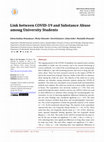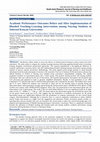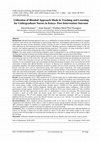Papers by David Kigaya Kaniaru

Saudi journal of nursing and health care, Oct 3, 2020
The use of cell phones can harm nursing students' academic performance. As such, reliance on the ... more The use of cell phones can harm nursing students' academic performance. As such, reliance on the device for everyday activities has increased. Consequently, "nomophobia", defined as the fear of being without one's smartphone, has emerged as a new phobia among the users. Aim: This study was aimed at identifying the effects that long-term use of smartphone has among students cause on their level of attention and learning styles. Methodology: A quasi-experimental study was carried out among nursing students in two public universities located in western Kenya. The sample size comprised of 811 third-and fourth-years nursing students with a control group (n = 349, 43. %) and an experimental group (n = 462, 57%). The experimental group left their cell phones, in sound or vibration mode, as they normally kept them, on a table located in the corner of the classroom. Data were analysed using SPSS v.25, and data presented using graphs and tables. The data was reliable at alpha .824 and without outliers. Results: More female 54.87% than male was evidenced by the responses. Both groups showed higher-than-average levels of nomophobia at the beginning of the class. As for problematic smartphone use and attention, it was found that there were statistically significant differences in both cases (U = 1355.500, Z = -2.830, P = .005; U = 1449.000, Z = -2.363, P = .018, respectively), and the experimental group had higher average scores, as well as in those related to knowledge. Testing of the hypothesis was done and the null hypothesis was rejected (X2=19.609, P>0.001). Conclusion: A relationship has been found between nomophobia and problematic smartphone use. Students who do not have access to their cell phones during class perceive more problematic cell phone usage, in addition to paying closer attention during class. Recommendation: Because of this, it is important to an alternative way of reducing the nomophobia in order to enhance attention and learning styles among students. Future studies are recommended on lecturers not only the students the medical students but also in other departments of the university and expand to other universities across the country.

OALib
The ongoing spread of the COVID-19 pandemic has exposed much systemic vulnerability to health car... more The ongoing spread of the COVID-19 pandemic has exposed much systemic vulnerability to health care, the economy, and to the normal functioning of society worldwide. As a result of the accumulating stress, many young people find it difficult to cope with mounting pressure and revert to drug and substance abuse. There has been increased research on the impact COVID-19 had on the normal lives of people. However, studies of this effect on substance abuse among the youth are scarce. The objective of the study was to assess substance use disorders among university students during the COVID-19 pandemic. The study was a descriptive cross-sectional study and Quantitative methods were adopted. The study was carried out in three public universities in Kenya. The respondents were university students (n = 278). Data were analyzed through descriptive statistics and one-way ANOVA which was used to check differences in substance abuse amongst the sociodemographic characteristics. In case of observing significant differences Bonferroni post-hoc test was used. Findings were considered significant at p < 0.05. The main outcome measures included drug abuse and sociodemographic characteristics. The overall computation revealed that generally majority of the student (n = 157, 56.5%) moderately abused drugs. The majority of the respondents reported that they very frequently abused alcohol (n = 152, 54.7%). Many noted that they very frequently abused miraa (n = 133, 47.8%). Moreover, many reported frequently abusing cigarettes; they less frequently abused Bhang (n = 138, 49.6). The results of the ANOVA revealed that the main effect for the year of study was significant, F (3, 266) = 3.86, p = 0.010, η p 2 = 0.04, indicating there were significant differences in Drug abuse mean score by study year levels. The main effect, religion was significant, F (3, 266

Open Journal of Epidemiology, 2018
Introduction: In Zimbabwe, where cervical cancer is the leading female malignancy, no systematic ... more Introduction: In Zimbabwe, where cervical cancer is the leading female malignancy, no systematic cervical screening program has been introduced. However, selective or opportunistic screening has been performed since the late 1980s. The Ministry of Health and Child Care is relying on screening, which allows early detection of pre-cancerous cells and diagnosis at early stages but many women are not going for the test and no studies have been done to find out why. This study investigated the women's perception about cervical cancer and its screening using health belief model (HBM) in Bulawayo, where they are two new screening clinics. Methods: We conducted an analytic cross-sectional study. Women from 18 years and above attending health facilities were included in the study. Interviewer administrated questionnaire was used to determine the proportion of screened women and elicit their perception about cervical cancer and its screening. Epi-info version 3.3.2 was used to do bivariate and multivariate analysis. Results: Two hundred women were recruited into the study. The proportion of women who had cervical cancer screening was 52 (26%). Pap smear only had 35 (17.5%) had VIAC only, 13 (6.5%) and Pap smear and VIAC had 4 (2%). Knowledge of cervical cancer and its screening was poor among participants. In multivariate analysis, awareness of cervical cancer screening ] was associated with the uptake of cervical cancer screening and perceiving that having multiple sexual partners[adjusted OR 0.33 (95% CI 0.12 -0.88)] was independently associated to the uptake of cervical cancer screening. Conclusion: This study demonstrated that lack of awareness of cervical cancer screening is a barrier to the uptake of the screening. Perceiving

South Asian research journal of nursing and healthcare, Nov 17, 2020
Introduction: Many studies to assess the efficacy of Internet-based learning in clinical nurses h... more Introduction: Many studies to assess the efficacy of Internet-based learning in clinical nurses have been undertaken. The study aimed to compare the resultant learning outcomes following applying blended mode in teachinglearning alongside conventional instructional approaches. The research hypothesized a non-significant difference in academic performance outcomes before and after implementing blended teaching-learning intervention among nursing students in Kenya's selected universities. Methodology: This study applied mixed design methods to obtain detailed information from the study participants of interest to the researcher. Four out of nineteen (4/19) universities in Kenya that offered Bachelor of Science in Nursing were sampled using convenience nonprobability sampling. The sample population included an experimental group and a control group. Only general nursing lecturers and nursing students participated. Data was collected by the use of observation, self-reported questionnaires. Descriptive and inferential data were processed and analyzed in order to generate simplified information. Results: A total population of (n= 486) comprised of 175 (36.0%) male and 311 (64%) female participants who consented for the study. The students had a mean age of 22 years. 302(62.1%) students were motivated to adopt and use the blended mode of learning during the intervention phase while participants strongly agreed during the preintervention phase, 405/486 (83.33%) agreed, 27/486 (5.56%) were neutral, while 39/486 (8.03%) disagreed. There were 353 observations in the Intervention group and 133 observations in the Control group. The result of the two-tailed Mann-Whitney U test was significant based on an alpha value of 0.05, U = 19280.5, z = -3.04, p = .002. The mean rank for the Intervention group was 65.03and the mean rank for the group Control group was 61.62. This suggests that the distribution of academic performance for the group Intervention group was significantly different from the distribution of academic performance for the Control group category. Recommendations: Although this is observed, there is a need to emphasize sensitization to reduce student's anxiety further and increase to a higher level the engagement and utilization. Further researchers should consider cooperating other relevant variables that were not featured in the current study to reduce the current Knowledge gap in the adoption and implementation of blended learning-teaching in Universities. Conclusion: There is a significant correlation between the utilization of blended teaching and learning mode and nursing students' academic performance among universities offering Bachelor of Science in Nursing in Kenya.

Most hospital staff nurses' work schedules extend beyond the typical 9:00 a.m. to 5:00 p.m., ... more Most hospital staff nurses' work schedules extend beyond the typical 9:00 a.m. to 5:00 p.m., Monday through Friday workday, to provide continuous nursing care to patients. Simultaneously, most hospitals in the United Counties exclusively use 12-hour shifts. Thus, staff nurses who work overtime may work more than 12 hours within 24 hours and return to work quickly without sufficient rest and sleep. Nurses' fatigue may continue the following work regardless of regular or overtime shifts. Working overtime among nurses is a prevalent practice used to control chronic understaffing and a standard method used to handle normal patient census variations. According to the 2004 National Sample Survey of Registered Nurses (NSSRN), more than 40% of Kenya registered community health nurses (KRCHN) worked more than 40 hours per week [21]. According to the ministry of health, fifty-four percent of the respondents to the 2018 NSSRN worked more than 39 hours per week in their principal nursin...

American Journal of Nursing Science, 2016
Preceptorship is a model of clinical training in which a qualified nurse, referred to as a precep... more Preceptorship is a model of clinical training in which a qualified nurse, referred to as a preceptor, is assigned to one or a group of nursing students, for the purpose of facilitating learning in the clinical setting. This study was done in Maua Methodist {M. M. H (Meru County, Kenya)} and Preyspeterian Churches East Africa (P. C. E. A) Chogoria (Tharaka-Nthi County, Kenya) hospitals in Meru, Kenya and its main objective was to determine the perceived need for preceptor-student nurse partnership in nursing training institution. A sample size of one hundred (100) respondents was randomly selected from a target population of one hundred and eighty (180) preceptees, by use of convenient sampling method. Ten (10) preceptors were also selected conveniently to participate in the study. One hundred and ten (110) questionnaires were distributed out of which ninety nine (99) were received back {(ninety-one-91) from preceptees and eight (8) from preceptors)}. Both, qualitative and quantitative descriptive survey designs was utilized. Descriptive statistics were used to analyse the resultant data. Regarding to the importance of having preceptors, results showed that eighty five out of ninety {85/90 (94.44%)} of the student nurses agreed that they are important while three (33.33%) disagreed. Eight out of nine {8/9 (88.88%)} of the preceptors agreed on the importance of preceptorship while one {1/9 (11.11%)} was not sure. The reasons according to students why they need these preceptors included; provision of directions and guidelines (90%), supervision (79%), resolve clinical conflicts between them and staff nurses (76%) and to have a role model to emulate (83%). For the preceptors-to have a good working environment (78%) and to act as role model (56%). Hence the need for the student-preceptor partnership during students nurses training period.

Background: Blended learning approach refers to a combination of online and face to face methods ... more Background: Blended learning approach refers to a combination of online and face to face methods in response to learner need and for the achievement of instructional objectives. Technological advancement in the world is influencing the nature of how disciplines conduct training. In order to match with this expectation, nursing has been influenced by both theoretical and clinical practice. Blending represents a fundamental change in the way teachers and students approach the teaching-learning experience. The practice of using technology to deliver coursework in Universities worldwide has seen a veritable explosion in adoption. Purpose: The study aimed at determining utilization scale of engagement in use of blended approach mode in teaching and learning in Kenyan universities. Methodology: This study applied mixed design method in order to obtained detailed information from the study participants of interest to the researcher. The study involved conducting teaching and managing one f...











Uploads
Papers by David Kigaya Kaniaru